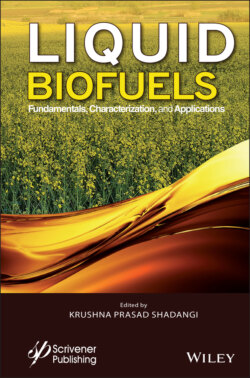Читать книгу Liquid Biofuels - Группа авторов - Страница 2
Table of Contents
Оглавление1 Cover
2 Title Page
3 Copyright
4 Preface
5 1 Introduction to Biomass to Biofuels Technologies 1.1 Introduction 1.2 Lignocellulosic Biomass and Its Composition 1.3 Types and Category of the Biomass 1.4 Methods of Conversion of Biomass to Liquid Biofuels 1.5 Bioethanol and Biobutanol Conversion Techniques 1.6 Biogas and Syngas Conversion Techniques 1.7 Advantages and Drawbacks of Biofuels 1.8 Applications of Biofuels 1.9 Future Prospects 1.10 Conclusion References
6 2 Advancements of Cavitation Technology in Biodiesel Production – from Fundamental Concept to Commercial Scale-Up 2.1 Introduction 2.2 Principles of Ultrasound and Cavitation 2.3 Intensification of Biodiesel Production Processes Through Cavitational Reactors 2.4 Designing the Cavitation Reactors 2.5 Scale-Up of Cavitational Reactors 2.6 Application of Cavitational Reactors for Large-Scale Biodiesel Production 2.7 Future Prospects and Challenges References
7 3 Heterogeneous Catalyst for Pyrolysis and Biodiesel Production 3.1 Biodiesel Production 3.2 Plastic Pyrolysis 3.3 Conclusion References
8 4 Algal Biofuel: Emergent Applications in Next-Generation Biofuel Technology 4.1 Introduction 4.2 Burgeoning of Biofuel Resources 4.3 Common Steps Adopted for Microalgal Biofuel Production 4.4 Types of Microalgal Biofuels and their Emerging Applications 4.5 Conclusion References
9 5 Co-Liquefaction of Biomass to Biofuels 5.1 Introduction 5.2 Hydrothermal Liquefaction (HTL) 5.3 Co-Liquefaction of Biomass 5.4 Current Development, Challenges and Future Perspectives 5.5 Conclusions Acknowledgments References
10 6 Biomass to Bio Jet Fuels: A Take Off to the Aviation Industry 6.1 Introduction 6.2 The Transition of Biomass to Biofuels 6.3 Properties of Aviation Jet Fuel (Bio-Jet Fuel) 6.4 Fuel Specification for Civil Aviation 6.5 Choice of Feedstock (Renewable Sources) 6.6 Pathways of Biomass to Bio-Jet Fuels 6.7 Challenges Associates with the Future of Bio-Jet Fuel Development 6.8 Future Perspective 6.9 Conclusion Acknowledgements References
11 7 Advance in Bioethanol Technology: Production and Characterization 7.1 Introduction 7.2 Production Technology of Ethanol and Global Players 7.3 Microbiology of Bioethanol Production 7.4 Fermentation Technology 7.5 Downstream Process 7.6 Ethanol Analysis 7.7 Conclusion References
12 8 Effect of Process Parameters on the Production of Pyrolytic Products from Biomass Through Pyrolysis 8.1 Introduction 8.2 Biomass to Energy Conversion Technologies 8.3 Advantages of Pyrolysis 8.4 Effect of Processing Parameters on Liquid Oil Yield 8.5 Types of Reactors 8.6 Advantages and Disadvantages of Different Types of Reactors 8.7 Conclusion Acknowledgements References
13 9 Thermo-Catalytic Conversion of Non-Edible Seeds (Extractive-Rich Biomass) to Fuel Oil 9.1 Introduction 9.2 Thermochemical Technologies for Liquid Biofuel Production 9.3 Feedstock Classification for Biofuel Production 9.4 Characterization of Non-Edible Oil Seeds 9.5 Thermal Degradation Profile of Different Non-Edible Seeds 9.6 Preparation of Raw Materials for Pyrolysis 9.7 Catalytic and Non-Catalytic Thermal Conversion for Liquid Fuel Production 9.8 Need for Up-Gradation of Pyrolytic Oil 9.9 Application of Catalyst in Pyrolysis of Non-Edible Biomass 9.10 Effect of Parameters on Liquid Fuel Production 9.11 Fuel Properties of Thermal and Catalytic Pyrolytic Oil 9.12 Challenges in Utilization of Nonedible Oil Seed in Themocatalytic Conversion Process 9.13 Advantages and Drawbacks of Seed Pyrolytic Oils 9.14 Precautions Associated with the Application of Biofuel 9.15 Conclusion and Future Perspectives References
14 10 Suitability of Oil Seed Residues as a Potential Source of Bio-Fuels and Bioenergy 10.1 Introduction 10.2 Biomass Conversion Processes 10.3 Biomass to Bioenergy via Thermal Pyrolysis 10.4 Physicochemical Characterization of Bio-Oil 10.5 Engine Performance Analysis 10.6 Future Prospects and Recommendations 10.7 Conclusion Acknowledgments References
15 11 Co-Conversion of Algal Biomass to Biofuel 11.1 Introduction 11.2 Mechanism of Co-Pyrolysis Process 11.3 Factors Impacting Co-Pyrolysis 11.4 Recent Advances and Studies on Co-Pyrolysis of Biomass and Different Substrates 11.5 Effect between Biomass and Different Substrates in Co-Pyrolysis 11.6 Future Perspectives 11.7 Conclusion References
16 12 Pyrolysis of Caryota Urens Seeds: Fuel Properties and Compositional Analysis 12.1 Introduction 12.2 Types of Pyrolysis Reactor 12.3 Materials and Methods 12.4 Product Analysis 12.5 Kinetic Modelling 12.6 Result and Discussion 12.7 Conclusion Acknowledgements Nomenclature References
17 13 Bio-Butanol as Biofuels: The Present and Future Scope 13.1 Introduction 13.2 Butanol Global Market 13.3 History of ABE Fermentation 13.4 Feedstocks 13.5 Pretreatment Techniques 13.6 Fermentation Techniques 13.7 Conclusion References
18 14 Application of Nanotechnology in the Production of Biofuel 14.1 Introduction 14.2 Various Nanoparticles Used for Production of Biofuel 14.3 Factors Affecting the Performance of Nanoparticles in the Manufacturing Process of Biofuel 14.4 Role of Nanomaterials in the Synthesis of Biofuels 14.5 Utilization of Nanomaterials for the Production of Biofuel 14.6 Conclusion References
19 15 Experimental Investigation of Long Run Viability of Engine Oil Properties in DI Diesel Engine Fuelled with Diesel, Bioethanol and Biodiesel Blend 15.1 Introduction 15.2 Materials and Method 15.3 Test Procedure 15.4 Result Analysis 15.5 Conclusion References
20 16 Studies on the Diesel Blends Oxidative Stability in Mixture with TBHQ Antioxidant and Soft Computation Approach Using ANN and RSM at Varying Blend Ratio 16.1 Introduction 16.2 Materials and Methodology 16.3 Results and Discussion 16.4 Response Surface Methodology for Performance Parameter 16.5 Modelling of ANN 16.6 Validation of RSM and ANN 16.7 Conclusion References
21 17 Effect of Nanoparticles in Bio-Oil on the Performance, Combustion and Emission Characteristics of a Diesel Engine 17.1 Introduction 17.2 Materials and Methods 17.3 Experimental Setup 17.4 Results and Discussion 17.5 Conclusions Abbreviations Nomenclature References
22 18 Use of Optimization Techniques to Study the Engine Performance and Emission Analysis of Diesel Engine 18.1 Introduction 18.2 Engine Parameter Optimization Using Taguchi’s S/N 18.3 Engine Parameter Optimization Using Response Surface Methodology 18.4 Artificial Neural Networks 18.5 Genetic Algorithm 18.6 TOPSIS Algorithm 18.7 Grey Relational Analysis 18.8 Fuzzy Optimization 18.9 Conclusion Abbreviations References
23 19 Engine Performance and Emission Analysis of Biodiesel-Diesel and Biomass Pyrolytic Oil-Diesel Blended Oil: A Comparative Study 19.1 Introduction 19.2 Experimental Analysis 19.3 Experimental Set-Up 19.4 Results and Discussion 19.5 Conclusion References
24 20 Agro-Waste for Second-Generation Biofuels 20.1 Introduction 20.2 Agro-Wastes 20.3 Value-Addition of Agro-Wastes 20.4 Production of Second-Generation Biofuels References
25 Index
26 Also of Interest
27 End User License Agreement
